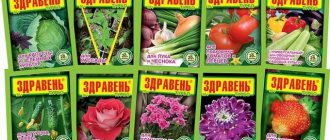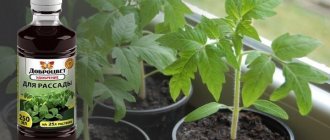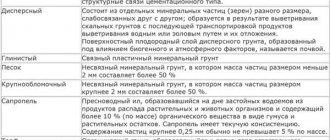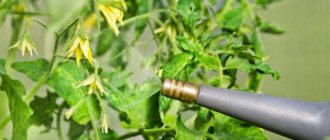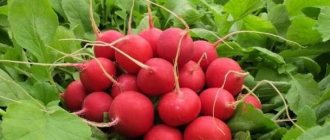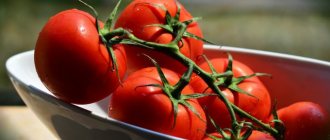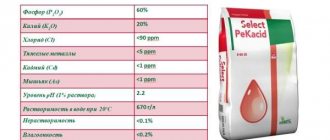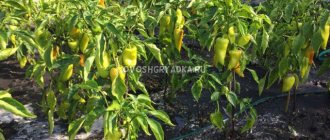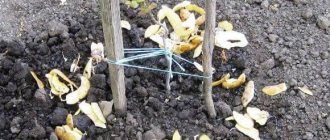Proper feeding of tomatoes
In the greenhouse, all shoots from below up to 3-4 brushes are removed, 1-2 of the strongest stepsons are left above them, and the top is pinched (Diagram 2).
For open ground, tomatoes are pinched and pinched like tall varieties. (see diagram 1a). Low-growing varieties usually do not shoot, but in temperate latitudes it is better to form bushes. In the greenhouse: all shoots are removed from below, 1-2 strong stepsons, 2-3 brushes are left above them and the top is pinched (Diagram 3). In open ground: remove all shoots from below, leave 2 stepsons and pinch the top. (3a).
Minerals for regular feeding
Mineral fertilizers are one substance or several substances mixed at certain concentrations. They can be divided into potassium, phosphorus, nitrogen, complex.
Among all phosphorus fertilizers, simple and double superphosphate are most often used. This tomato fertilizer is a gray (white) powder or granules. Their peculiarity is that they are poorly soluble in water and before use it is recommended to infuse them in water for 24 hours to obtain an extract.
Nitrogen fertilizers for tomatoes are often used in the early stages of cultivation, when it is necessary to accelerate plant growth. Such fertilizers include nitrate (ammonium, potassium, sodium), urea, and ammonium sulfate. In addition to the main substance, these nitrogen fertilizers may contain some other minerals in small quantities.
Potassium is a very important trace element that helps tomatoes develop their root system and supply nutrients from the root to the leaves and fruits. With enough potassium, the crop will have a good taste. Among potassium fertilizers for tomatoes, it is recommended to use potassium magnesium or potassium sulfate. Potassium chloride should not be used as a fertilizer, since tomatoes react negatively to chlorine.
In addition to the above fertilizers, you can find magnesium, calcium, sodium, boron and other preparations with one main mineral.
Thus, knowing simple mineral fertilizers, it is quite easy to prepare fertilizers yourself, combining various substances. Using only one type of mineral you can compensate for the lack of the corresponding substance.
Mineral fertilizers can be used repeatedly throughout the growing of tomatoes. So, during soil preparation you can use urea. The substance is scattered over the surface of the soil before digging in an amount of 20 g/m2.
You can also use a mineral complex created by yourself to feed tomato seedlings. To prepare it, you need to dissolve ammonium nitrate (20 g) in a bucket of clean water. The resulting liquid should be watered or sprayed on the tomato seedlings.
Before planting in the ground, young plants need to be fertilized with potassium and phosphorus, which will allow them to take root better. To do this, add potassium sulfate and superphosphate (15-25 g of each substance) to a bucket of water.
After planting in the ground, tomatoes can be fertilized with a nutrient mixture: 35-40 g of superphosphate (double), 20 g of potassium sulfate and 15 g of urea per 10 liters of water. This mineral complex saturates the tomatoes with nitrogen, potassium, phosphorus and other minerals, as a result of which the plants develop harmoniously, form abundant ovaries and produce abundant fruit of good-tasting vegetables.
An alternative to such a complex can be a liquid fertilizer obtained by adding 80 g of simple superphosphate, 5-10 g of ammonium nitrate and 30 g of potassium sulfate to a bucket of water. The fertilizer can be used in greenhouses and on open ground many times, at intervals of several weeks. After feeding with this complex, tomatoes will have high viability and resistance to diseases and cold.
Foliar feeding of tomatoes can be done using boric acid. A solution of this substance will fertilize the plants and protect them from pests. Dissolve acid for spraying at the rate of 10 g per 10 l.
By combining simple, one-component fertilizers, you can adjust the amount of minerals in the fertilizer depending on the fertility of the soil and the condition of the tomatoes. It should also be noted that the cost of such fertilizers will be lower than the cost of similar ready-made, complex mineral fertilizers.
For those farmers who do not want to combine minerals on their own, complex mineral fertilizers are offered. They contain all the necessary substances for the growth of tomatoes at a certain stage of the growing season. The advantage of complex fertilizers is their efficiency and ease of use.
Complex, or multifaceted, fertilizers simultaneously contain two or more basic nutrients, as well as microelements.
Ammophos is a highly effective, granular nitrogen-phosphorus fertilizer of the highest grade. The concentration of main nutrients in ammophos is 52% phosphorus and 12% nitrogen presented in ammonium form. Ammophos is a chlorine-free, nitrate-free fertilizer with the highest concentration of phosphorus. It is used on all types of soils for main and row application, for feeding during the growing season for main crops in open and closed ground conditions.
Timely application of ammophos protects the root system and increases the frost resistance of plants, accelerates the process of formation and ripening of fruits, and improves their quality characteristics during storage. It has good physical and chemical properties, is not hygroscopic, does not generate dust and does not cake. Physiologically neutral fertilizer, has a uniform granulometric composition and is highly soluble in water.
| Culture. | Basic application | Top dressing |
| Vegetables. | 20-30 g per 1 sq. m. | 5-10 g per 1 linear meter in row spacing to a depth of 6 - 8 cm. |
| Roots. | 15-25 g per 1 sq. m. | 5-10 g per 1 linear meter in row spacing to a depth of 6 - 8 cm. |
| Fruit. | 15-30 g per 1 sq. m of tree trunk circle. | 5-10 g per 1 sq. m. |
Types of fertilizers used for potatoes
Like other crops, potatoes can be fed with fertilizers of organic and synthetic origin. In turn, synthetic types of fertilizers for potatoes include simple and complex mineral and complex fertilizers. There are also modern organomineral mixtures consisting of both organic and mineral components.
Organic
To grow potatoes you will need 3 main elements and microelements. They can be found in the manure of any domestic farm animals and poultry, but it is still better to use mullein, horse manure or chicken manure. Manure contains N, P and K in varying proportions, as well as calcium and magnesium. It is used only in diluted form: before application, it is diluted with water in a ratio of 1 to 15 and left to infuse in a warm place for 2-3 days. The consumption rate is 1 liter for each bush.
Manure for potato plants can be taken fresh, but it is better to use rotted manure: fresh manure affects the growth of tops rather than tubers. In addition to humus, compost can be used as organic fertilizer for potatoes - not fresh, but already rotted plant residues, tops of garden crops and tree leaves.
As an organic fertilizer containing calcium, you can use eggshells, which consist almost entirely of calcium carbonate. It needs to be dried and crushed to a powdery state, and then embedded in the soil in potato beds.
Mineral
Organic matter can be replaced by applying fertilizers of mineral origin. As a home remedy that is always at hand, you can use ordinary ash obtained from burning plant residues and tree branches, preferably deciduous trees. It contains F, Ca, Mn, Si, K, Cl, Na, S, B, etc., almost all elements except nitrogen. Therefore, the addition of ash as a fertilizer for potatoes along with manure completely replaces any fertilizer of mineral origin.
Mineral fertilizers usually contain 1 or 2-3 nutrients in pure form and in much higher concentrations than in organic matter. It is convenient to apply them at certain stages of development of potato plants in order to provide them with exactly the elements that are needed at this time of the growing season.
At the beginning of its development, potatoes grow tops, which require nitrogen for normal growth, so ammonium nitrate is added in the first spring feeding in the amount of 20-30 g per square meter. m or 5 g per well. In it this element is in the most accessible form. Nitrate for potatoes is an indispensable spring fertilizer that is available to all vegetable growers: you just need to purchase it at a vegetable growing store. Using urea for potatoes gives the same effect, but it only needs to be applied in the fall, during the autumn digging of the beds.
As a concentrated mixture for potato plants containing phosphorus, superphosphate, simple or double, is mainly used. It can be used both at the planting stage, adding 3-4 g to the holes, and for subsequent feeding after flowering, when tubers begin to form.
The importance of potassium fertilizers for potatoes has also been established: they accelerate growth processes and enhance the accumulation of starch in tubers. A deficiency of this element is manifested by weak growth, decreased yield, resistance to infections and frost resistance, and darkening of the pulp of tubers during processing.
The effectiveness of nutrient mixtures containing the element potassium is determined by how much of it is in the soil in exchangeable form, as well as its type: on light soils and peatlands, the need for this element increases. It is permissible to use for potatoes: potassium sulfate, potassium nitrate, potassium magnesium.
Chlorine-containing fertilizers: potassium salts and potassium chloride are incorporated into the soil only in the fall, because potatoes do not like chlorine: after winter there is no chlorine left in the soil.
Complex
Complex fertilizers are powders or granules that contain all 3 elements at once + may also contain microelements. This is very convenient, since in one application the bush immediately receives all the compounds it needs. For example, in the spring, when planting potatoes, you can add 1 tsp into the holes. nitroammophoska, which contains all 3 elements in a fairly concentrated form. This compound stimulates root development well and greatly increases the yield volume.
Article on the topic: Potato yield per 1 hectare in Russia and the world - analysis
Instead of nitroammophoska, you can use azofoska, which, in addition to 3 elements, also contains sulfur. In general, both of these substances are very similar, both in composition and in the effect they have on garden plants.
Among mineral fertilizers containing N, K and P, nitrophoska can also be applied to potatoes. There are 3 types of this fertilizer: sulfate, phosphorite and sulfate. It is better to apply phosphorite nitrophoska on heavy loams, sulphate - on sandy loams, and it is also useful for foliar feeding. In addition to nutritional properties, it also has fungicidal properties, as it contains sulfur.
You can also use any complex fertilizer for potatoes with microelements:
There are other complex preparations suitable for application to potatoes.
Organomineral fertilizers (OMF)
OMU is a combination of organic and mineral components in one fertilizer. The effect of their use is expressed in improving the physical and chemical properties of the soil, increasing moisture capacity, looseness and reducing its volumetric mass. WMD do not salinize the soil, which happens when large doses of mineral fertilizers are used. The nutrients contained in their granules are evenly distributed in the soil and released in the amount required by plants.
Advantages and use of fertilizer "Red Giant"
trunk circle.
Berry bushes. 15-30 g per 1 sq. m. 4-5 g per 1 sq. m. Flowers, lawn grass. 15-20 g per 1 sq. m. 4-5 g per 1 sq. m.We invite you to familiarize yourself with: Characteristics of the Major tomato variety and features of agricultural technology
Ammofoska is a complex, three-component, nitrogen (15%) - phosphorus (15%) - potassium fertilizer (15%). The concentration of fertilizer nutrients is 45%, which makes ammophoska economically advantageous in comparison with simple one-component fertilizers and can significantly reduce the costs of transportation, storage and application.
A highly effective complex fertilizer that contains four main nutritional components: nitrogen, phosphorus, potassium, sulfur - and two additional ones: calcium and magnesium
Used on various soils for all agricultural crops, but especially recommended for crops sensitive to chlorine: fruits and berries, potatoes, vegetables, vineyards, tobacco, flowers
The versatile and balanced content of mineral nutrition elements ensures uniform and healthy growth of plants throughout the growing season, increases their immunity and resistance to disease
Increases crop yields, shelf life of products, improves the quality of fruits in terms of vitamin, protein and carbohydrate composition
Improves the processes of tillering and fertilization, the decorative qualities of flowers. The application of fertilizer during sowing contributes to a good supply of nutritional elements to young plants, due to the concentration of granules around the seeds and roots of seedlings. The gradual dissolution of fertilizer granules ensures complete nutrition of plants for a long time, and also promotes their intensive tillering and prolonged flowering. On poor soils and in years with high rainfall, plants are additionally fertilized during the growing season.
Basic application: when digging the soil in spring or autumn, apply 15-20g for potatoes, vegetables, strawberries, and ornamental crops. for 1 sq. m for cultivated soils
and 25-30 gr. per 1 sq. m. for uncultivated soils.
In greenhouses and greenhouses, 40-50 grams are added when digging. for 1 sq. m.
Top dressing: for vegetable and ornamental crops - 5-10g. for 1 sq. m;
for berry bushes - 15-20 gr. for 1 sq. m;
for fruit trees -20-30 gr. per 1 sq.m of tree trunk circle.
Fertilizers are evenly scattered on the soil surface, followed by incorporation by loosening, then watering is carried out.
Nitroammofoska (Azofoska) is a highly effective, complex mineral fertilizer with sulfur. Chemical composition of the fertilizer: nitrogen 16%, easily digestible phosphorus 16%, potassium 16%, sulfur 2%. All components are present in one granule, thanks to this a more uniform distribution of all active substances in the soil is possible.
Available in the form of light pink granules with a diameter of 2-3 mm. It dissolves in water somewhat less well than nitrogen and potassium fertilizers, but better than phosphorus fertilizers. Nitroammofoska is applied in the fall when digging up the garden for any crop. Can be used for spring and summer feeding in small doses, preferably in dissolved form.
Features of ready-made fertilizers
The main purpose of ready-made fertilizers is to fill that very niche in plant nutrition that the soil of a given site or region cannot fill.
The reasons may be different: poor soil cover, water or wind erosion, poor crop rotation, etc. Fertilizers are divided into several groups based on their chemical composition.
- Organic and organomineral . Organic includes substances exclusively of plant and animal origin - manure, peat, compost. Most often they are prepared right on site. Fertilizers of this kind improve the physical, chemical, biological properties of the soil, air and water conditions.
- Mineral . Substances of inorganic origin. They can be solid and liquid, homogeneous and complex. Based on the nutritional element, they are divided into microfertilizers (zinc, manganese, boron) and macrofertilizers (phosphorus, potassium, nitrogen, calcium, sulfur).
- Bacterial . These drugs promote the development of bacteria that affect the nutritional regime of the soil. Contains certain types of microorganisms. There are phytohormones, growth stimulants, drainage and ameliorants.
We invite you to watch a video about what fertilizers are suitable for feeding tomatoes:
Complex mineral fertilizers
When feeding in summer, for example, immediately after flowering of berries and fruit crops, 1.5 matchboxes of nitroammophoska or 2 boxes of nitrophoska are dissolved in 1 bucket of water. This solution is used for 5-6 m of a row of strawberries or raspberries, for 1 currant or gooseberry bush. Cherries and plums are fed with this solution at the rate of 2 buckets per tree, and apple trees, depending on size, at the rate of 3-4 buckets. After any fertilizing, the garden should be well watered.
Nitrophoska is used as a basic and pre-sowing mineral fertilizer on any soil and for all crops. Contains: nitrogen – 11%, phosphorus – 10%, potassium – 11%. Nitrophoska is recommended for use when sowing beets, potatoes and other crops that require potassium. Due to the low concentration of phosphorus, the fertilizer is widely used on soils with a high phosphorus content or after phosphorite treatment.
The increased content of ammonia nitrogen in nitrophoska reduces nitrogen losses from leaching from the soil and promotes long-term nitrogen nutrition of crops. Apply in doses 1.5 times greater than for nitroammophoska: 70-80 g per 1 sq.m. It is well stored and, when diluted, forms a precipitate in the form of an insoluble phosphorus compound.
The content of all four nutritional components in one granule ensures uniform distribution of active substances in the soil, which contributes to the uniform emergence of seedlings and intensive development of plants. Sulfur, added together with nitrogen, takes part in the process of protein synthesis and helps to increase the efficiency of nitrogen absorption.
Complex special fertilizers
Special complex fertilizers are created for application to specific types of plants. Their formulation takes into account the specific needs of plants for nitrogen, phosphorus, potassium and microelements.
Complex mineral fertilizer for strawberries
The composition and ratio of nutrients in complex mineral fertilizer for strawberries is selected taking into account the mineral nutrition requirements of strawberries.
Purpose: intended for complete nutrition of strawberries.
| The name of indicators: | |
| Nitrogen N, % | 14,0 |
| Phosphorus P2O5, % | 7,0 |
| Potassium K2O,% | 27,0 |
| Magnesium MgO,% | 0,5 |
| Microelements, % | presence |
When laying strawberry beds 50 g/m2.
Fertilizing in early spring and after harvesting 15 - 20 g per 1 m of row.
Complex mineral fertilizer for potatoes
The composition and ratio of nutritional elements of complex mineral fertilizer for potatoes is selected taking into account the requirements of the potato crop for mineral nutrition.
Purpose: intended for complete nutrition of potato crops.
| The name of indicators: | |
| Nitrogen N, % | 10,0 |
| Phosphorus P2O5, % | 6,0 |
| Potassium K2O,% | 16,0 |
| Magnesium MgO,% | 6,0 |
| Microelements, % | presence |
Spreading before digging the soil 50 - 60 g/m2.
When planting potatoes in a hole, 10 grams per hole.
Top dressing (before hilling 20 grams per 1 meter of row
Complex mineral fertilizer for lawns
The composition and ratio of nutritional elements of complex mineral fertilizer for lawns is selected taking into account the mineral nutrition requirements of various types of lawn grasses.
Purpose: intended for complete nutrition of various types of lawns.
| The name of indicators: | |
| Nitrogen N, % | 20,0 |
| Phosphorus P2O5, % | 5,0 |
| Potassium K2O,% | 15,0 |
| Magnesium MgO,% | 1,0 |
| Microelements, % | presence |
Application to the soil when laying a lawn 50 - 60 g/m2 (evenly distributing fertilizer in a soil layer of 0 -5 cm)
15 - 20 g/m2 in dry form is added to the fertilizer, evenly distributing the fertilizer over the surface of the lawn.
After feeding, be sure to water. Fertilizing is carried out after mowing the lawn.
Complex mineral fertilizer for onions and garlic is a specialized long-acting fertilizer intended for growing onions and garlic. Contains essential nutrients in proportions optimal for plant development. Promotes healthy growth, rich and high-quality harvests.
| Nitrogen N, % | |
| Phosphorus P2O5, % | 5,5 |
| Potassium K2O,% | 5,5 |
| Mg, Fe, S, B, Cu, Zn, Ca humates | presence |
We suggest you familiarize yourself with: What ammonium nitrate consists of, fertilizer composition
A solution is a complex fertilizer that requires dissolution in water to be used. Description: suitable for fertilizing when growing plants in open ground, hotbeds and greenhouses. It can be used to enrich the soil with nutrients when digging in the spring.
When and how to apply fertilizer correctly
You can prepare soil for potatoes both in the fall, at the end of the season, and in the spring. Tillage is equally permissible in both periods, the only difference is that different fertilizers are used.
Autumn site preparation
During autumn preparation, fresh manure or rotted humus (at the rate of 15 kg per 1 sq. m) and ash are used. Among the mineral mixtures suitable for fertilizing soil under potatoes are urea (30 g per 1 sq. m), superphosphate and potassium sulfate (15 g each). At the same time, acidic soils are limed, adding per 1 sq. m 200 g of lime, wood ash or dolomite flour.
Spring preparation of the site and when planting potatoes in holes
When preparing the soil for potatoes in the spring, you can also add various fertilizers to it. This can be humus, compost or complex compositions, in particular, such as the “Potato Formula”. It is embedded in the ground at the rate of 60 g per 1 square meter. m. You can apply this fertilizer directly into the holes when planting, 15-20 g, which will not only strengthen the plants, but also repel wireworms and beetles from them.
If there are few fertilizers (organic or mineral), then you can not embed them in the ground, but simply put 200-300 g of humus and 1-2 tbsp in the holes. l. ash. Synthetic fertilizers can also be used. How much of these fertilizers is needed for potatoes when planting in a hole can be calculated based on the application rates specified in the instructions for each square meter. m.
Before planting, potato tubers are treated with the preparation “Prestige”: 15 ml is diluted in 3 liters of water, mixed and all planting material is sprayed from a sprayer. This amount of liquid should be enough for 10-15 kg of tubers. They must be planted immediately after treatment.
After landing
Fertilizer application is not limited to pre-planting preparation; potatoes are also fertilized after planting. They are applied several times during the growing season of this vegetable crop. Perform both root and foliar feeding.
Root feeding
The first fertilizing of potatoes after germination is carried out after the first hilling. Before applying fertilizers, lightly loosen the soil so that they penetrate into it more quickly. First, the plants are fertilized with slurry or poultry droppings. The solution is prepared at the rate of 1 to 10 or 1 to 20 and poured into the grooves dug between the rows. Or use saltpeter - dissolve 1 tbsp. l. in a bucket of water and pour 1 liter of this solution onto each plant. Then the potatoes are covered with peat or sawdust.
A nutritious herbal infusion is also prepared from any weeds found in the garden. They are soaked in a large barrel for 1 week, and after the mixture has fermented, the liquid is filtered and poured over the potatoes. This fertilizing is considered a good source of nitrogen.
The second application is made before flowering begins. This time, potassium and phosphorus are added as part of superphosphate or any potassium fertilizer, except chlorine-containing fertilizer. You can prepare solutions or simply scatter granules around the bushes. In both cases, the potatoes must then be watered abundantly so that the fertilizers quickly penetrate to the roots of the bushes. After flowering, a third feeding is done, again with potassium and phosphorus. Use the same fertilizers or ash solution.
Related article: Roundup for potatoes: description, instructions, dosage, harm
The rates for applying synthetic fertilizers to potatoes can be found in the instructions for use, which are attached to each such fertilizer. They should not be reduced or exceeded: both deficiency and excess of nutrients have a bad effect on both the plants themselves and the harvest as a whole.
Foliar feeding
In addition to the root ones, foliar subcortex of potatoes is also used: through the leaves, the plant receives all the missing elements as easily as through the roots. Time: morning or evening, in clear weather.
The first such feeding is done 1.5 weeks after potato shoots appear. Prepare a solution of urea (no more than 5 g per 10 l), carefully dissolve the granules in water and spray the bushes with a spray bottle.
At the beginning of flowering, potatoes are sprayed with a weak solution of nitrate, potassium sulfate, superphosphate (2 g per 10 l). And finally, when the tubers begin to form, the potatoes are sprayed again: this time with a weak solution of manganese and boron to improve the taste of the tubers and prevent the appearance of voids in them. You can use Mag-Bor fertilizer (1 tbsp per 10 l).
Feeding potato bushes with fertilizers is a necessary condition for obtaining a generous, high-quality harvest of tubers from them. The main thing is to add all the substances correctly and on time.
Advantages and use of fertilizer "Red Giant"
The advantages of complex fertilizers include:
- high content of useful elements;
- absence or insignificant content of chlorine, sodium and other ions;
- the presence of all nutritional components in one granule;
- getting excellent results.
Complex fertilizers have the only drawback - compared to other types, they are not represented in a very wide range.
trunk circle.
Compound
The composition of the drug includes all the main nutritional components and microelements. These are the following elements:
- Zinc;
- Magnesium;
- B vitamins;
- Nitrogen in various forms;
- Phosphorus;
- Potassium.
The components are presented in salt form. The composition of the drug provides the following effects when used:
- Balancing the nutrition of crops when growing them within a limited space for the root system;
- Stimulating growth processes, which allows you to get a harvest in a shorter time. This effect is achieved due to the increased concentration of nutrients;
- An excellent effect when carrying out foliar feeding, since all components are presented in a form that is easily digestible;
- All components are perfectly soluble;
- The composition contains a complete list of macroelements and microelements necessary for crops.
This is an effective product that is used for various types of fertilizing.
By using nutritious fertilizers, you can make the soil composition richer and more nutritious. In an enriched substrate, seedlings will grow much better. You can use one of the following types of fertilizers.
Master NPK-17.6.18
Master NPK-17.6.18 fertilizer contains large quantities of potassium and nitrogen, and little phosphorus. Thanks to this ratio, the plant acquires a dark green color and its growing season proceeds well. Tomatoes become more resistant to adverse weather, bloom longer and produce larger yields. It is recommended to feed during the growth and flowering stages.
Crystallon
Kristalon fertilizer contains macro- and microelements that tomatoes need at various stages of their development. Eventually:
- the soil composition becomes balanced;
- seedlings grow faster;
- the productivity and resistance of fruits to diseases increases;
- plants can more easily tolerate sudden temperature fluctuations and drought;
- the development of green mass and root system is activated;
- the quality of tomatoes improves.
To feed the seedlings, foliar feeding is done with a solution of green Crystalon - 1-1.5 grams per 1 liter of water. drug. After planting it in open ground, it must be treated with the yellow type of this fertilizer. This will help the seedlings to become stronger. The procedure is carried out for the first 4 weeks with a solution based on 1 liter of water. fertilizers
It is noted that this fertilizer reduces the level of negative effects of pesticides on tomatoes. Crystalon dissolves slowly in the soil, which indicates its long-lasting effect.
Important! The types of this fertilizer can be mixed with each other and with other preparations, with the exception of those that contain metals.
Description of the fertilizer
Saving their time, gardeners often buy ready-made complex fertilizers for tomatoes. The “Red Giant” fertilizer showed good results.
The drug is a completely balanced mixture of trace elements and minerals. It is designed specifically for tomatoes and aims to support their development at all stages. It is used in the autumn and spring periods, during digging or plowing, and also as a feed for the roots of seedlings. The drug is effective on any soil, especially acidic and neutral. The substance does not upset the balance of the plant’s vital functions, but only supports its natural processes.
Advantages of the "Giant":
- good solubility in water;
- prolonged action;
- reducing soil acidity;
- absence of nitrates and other harmful components;
- one-time use gives a visible positive result;
- versatility;
- high positive receptivity of plants;
- nutrients are not washed out of the soil;
- ease of use;
- harmless to humans, soil, and the environment.
The “Red Giant” fertilizer for tomatoes has proven itself to be excellent as a remedy against wireworms.
Basic properties of fertilizing:
- increasing plant immunity: they become more resistant to diseases such as late blight, root rot, etc.;
- increase in productivity;
- improving the taste of tomatoes;
- the result of the action is visible after a short period of time: the plant better tolerates temperature changes, drought, high humidity, and frost;
What crops is Mortar suitable for?
What can be fertilized with Mortar? The drug is suitable for the following groups of plants:
- Cereals;
- Vegetables;
- Fruit;
- Berry;
- Lawn;
- Conifers and others.
There are different types of Solution with different contents and concentrations of active components. A different preparation should be selected for each crop.
Features of use: In closed ground, the product is used through irrigation and sprinkling systems. There are several brands of Mortar that are designed for different developmental stages. This ensures harmonious growth of plants throughout their development.
It is also applicable for foliar feeding. This promotes better absorption of all nutrients. This feeding is a spraying with the use of the drug. It not only provides effective nutrition, but also allows you to vary the saturation of crops with nutrients at different phases of their development.
Fertilizer is often used in open ground conditions. In this case, it is suitable for both spraying and root procedures. It is allowed to mix products with drugs that provide protection against diseases and pests. What is it for? This serves two purposes:
- Reducing stress loads inevitable when using protective equipment;
- Reducing labor costs for soil cultivation.
All these nuances make the product universal and required in a summer cottage.
Instructions for use If this is a basic application, it should be done in the spring months when digging the soil. You will need 45-55 grams of substance per square meter. meter. Suitable for flower, potato and vegetable crops. Instructions:
- The first feeding is carried out at a time depending on the type of plant. If these are tomatoes, it is necessary to carry out the procedure when 5-6 leaf plates are formed, cucumbers - 5-10 days after the emergence of seedlings, carrots and root vegetables - 20-30 days after the formation of seedlings;
- The second feeding is carried out at the beginning of fruit set and root formation. Per sq. meter will require 7-10 grams of composition;
- For potato crops, the first fertilizing is planned at the beginning of flowering. The subsequent one is performed when tubers form. Per sq. meter requires 10-12 grams;
- For strawberries and fruit and berry species, the application rate is 10-20 grams (strawberries) and 25-30 grams (other crops). The first application is carried out immediately after the snow has melted.
Fertilizer “Red Giant” 1 kg
The second procedure is implemented after flowering;
For foliar feeding, you will need to prepare a working solution. It will require diluting 20-40 g in a bucket of water. The procedure is carried out in cloudy weather. It is better to plan them at the beginning or end of the day. This will help protect the leaf plates from burns.
Means for tomato seedlings
In the Russian climate, it is customary to grow tomatoes in a greenhouse, which creates more suitable conditions, unlike open ground, for their successful growth. However, the presence of this design is not enough to obtain a rich harvest - you also need plant care, which includes proper watering, pinching, staking and bait. How to feed tomatoes?
We invite you to read: Mole - photo and description of the animal
Root feeding is the application of fertilizer to the soil with the plant, which must be supplied with various substances, while foliar feeding is watering the plant with water with fertilizer dissolved in it. It is worth noting that tomatoes are susceptible to both types of this procedure, so they should be combined.
The quality of tomato seedling material can be judged by its appearance. A healthy plant will have a thick and short stem with a purple tint, the leaves will be dense, and the first cluster will be low. In order for the seedlings to be good, it is necessary to use special fertilizers.
Nitroammofoska
It is used dry or diluted with water. Dry Nitroammofoska is applied in bulk to the ground, and the liquid is watered over the plants. It helps to increase the ovaries of tomatoes. To do this, take a matchbox of this fertilizer in a bucket of water and pour 500 ml of the prepared solution under each tomato bush. This fertilizer can be applied along with:
- sodium humate;
- potassium sulfate;
- mullein
Sturdy
Water-soluble fertilizer Krepysh is produced in liquid and dry form. This fertilizer contains all the stimulants, micro- and macroelements that tomatoes need, for example:
- potassium;
- magnesium;
- nitrogen;
- iron.
This carefully balanced fertilizer must be applied to the soil when watering. It is recommended to feed Krepysh for the first time after the second leaf has formed, and then during picking. Then you need to fertilize every 2 weeks until flowering begins. To feed seedlings, dilute 2 teaspoons of Krepysh in 10 liters of water.
Fertilizer selection
First of all, when feeding bait, you need to decide on the composition of the fertilizer, as this can significantly affect the result. Mineral fertilizers are better suited for tomatoes, the most popular of which are the following:
- Nitrogen;
- Potassium;
- Phosphorus.
If there is a lack of phosphorus in tomatoes, nitrogen absorption deteriorates, resulting in slower fruit development. Phosphorus starvation can be identified by red and purple spots on the leaves and their curling. As for potassium, when it is deficient, plants begin to wither, since due to a lack of carbon dioxide and, as a consequence, an excess of ammonia nitrogen, the formation of stems on tomato bushes is disrupted.
Tomatoes often suffer from blossom end rot due to a lack of calcium, and when there is a lack of nitrogen, their growth slows down. To eliminate the shortcomings, calcium acid-based products and urea solution are used, respectively.
The influence of the amount of minerals on the crop
Tomatoes especially need three minerals that influence development: nitrogen, phosphorus and potassium. The amount of microelements that also form their structure is also important. For gardeners who grow tomatoes, complex fertilizers will significantly improve labor results. And in greenhouses there is no way to do without fertilizing tomatoes.
Nitrogen
The growth of green mass by tomato plants and their healthy appearance depends on the presence of nitrogen in the soil. With a lack of mineral, the leaves turn yellow and the veins below become bluish. The stems are thin and emaciated. Planting will be helped by the addition of ammonium nitrate, which acidifies the soil, or urea, which makes the soil more alkaline.
Phosphorus
The element strengthens the immune system of tomatoes, promotes root growth, the formation of buds and fruits. If there is not enough phosphorus in the soil, the tomato stems below become purple. The leaves subsequently become of the same dark shade, which also bend inward. The stem is fragile and breaks easily. Use superphosphate or phosphorus flour.
Potassium
The mineral in a balanced amount increases immunity and productivity of crops, improves the taste properties of fruits. But if the dose is exceeded, the fruits become deformed. A signal about a lack of potassium in tomatoes is the appearance of a light stripe along the edges of the leaves and spots on the entire plate. The leaves gradually darken and curl. Potassium is absorbed by plants in the composition of salts: chloride and sulfate. But chlorine can damage the root system of tomatoes, and its use worsens the taste of the fruit. Therefore, potassium chloride is often incorporated into the ground in the fall, and potassium sulfate is used to fertilize tomatoes in spring and summer.
Analyzing the rules for applying fertilizers, any gardener who is not experienced in agronomy will say that it is better to use complex mineral fertilizers for tomatoes. Moreover, they also contain other minerals that are valuable for tomatoes.
Important! When feeding tomatoes, fertilize the soil around the plant, retreating 10 cm from the stem.
Microelements
Tomatoes also need calcium, manganese, boron, magnesium and other elements in balanced amounts.
- Magnesium is needed for photosynthesis to form chlorophyll. If there is a lack of an element, the plant turns pale.
- Calcium stabilizes metabolism and participates in the development of roots and fruits. In tomatoes with calcium deficiency, blossom end rot appears.
- Improves the development and taste of boron fruits. With its participation, vitamin C and sugars accumulate. Lack of boron affects the darkening of fruits and the formation of black spots on the stems.
- Manganese is important for photosynthesis. Its deficiency leads to depletion of leaves.
- With the help of molybdenum, the plant absorbs nitrogen from the air and exchanges other minerals.
- Sulfur is responsible for the synthesis of amino acids, then proteins.
- Zinc is involved in the synthesis of vitamins and metabolism.
Root feeding
Most often, during the growing period from planting seedlings to harvesting, tomatoes receive three feedings: before planting seedlings or after picking, during flowering, and at the moment when abundant fruiting begins.
The first time fertilizing is done even before planting the seedlings - the soil in the greenhouse is fertilized with compost and humus with the addition of wood ash. These measures will allow tomato seedlings to take root in the greenhouse due to the abundance of minerals in compost and humus and a large number of useful microelements in wood ash.
A common use is the so-called “green tea” - a solution made by mixing various herbs, including nettle, plantain and weeds, with ash and mullein.
The use of foliar feeding is determined by the quality of tomato growth: if problems are observed with the growth rate of stems, fruit set and other aspects of plant life, they should be additionally supplied with nutrients. The procedure is usually carried out by spraying tomatoes with a special solution during watering.
In addition, combined fertilizers consisting of several elements are used. For example, quite popular combined fertilizers are a composition based on nitrophoska and ammophos. They are easily absorbed by tomatoes and are used to compensate for the lack of certain nutrients, and in addition, the effect of their use is noticeable much earlier than from root feeding.
It is worth noting that feeding tomatoes does not have a specific scheme - it can vary depending on the variety of tomatoes, soil quality, climate, possible diseases and pests and many other factors. Carrying out this procedure is not a mandatory parameter for obtaining a good harvest, but most often the growing conditions are quite far from ideal, and here this procedure provides the gardener with an indispensable service.
Fertilizer “Red Giant” for tomatoes Ivanovskoye, 1 kg
For the most part, this method is used in cases where transplanting seedlings into a greenhouse was not entirely successful and it was injured.
Provided that the soil in the greenhouse is of sufficient quality, for example, purchased from a special store, you do not need to fertilize it separately. In this case, the first feeding is carried out 20 days after the tomato picking procedure. By watering the plants, a mixture consisting of 25 grams of nitrogen, 40 grams of phosphorus and 15 grams of potassium is added to the root, diluting which will require 10 liters of water.
Tomatoes usually receive the second feeding during the period of ovary formation, since at this time the plants need a large amount of additional nutrients. To carry it out, potassium sulfate and bird droppings are used, in the proportion of a tablespoon and 0.5 liters per 10 liters of water. Then add 0.5 liters of mullein solution to this mixture.
At the flowering stage, measures are taken to prevent diseases such as blossom end rot in tomatoes. To solve this problem, nitrophoska dissolved in water is used, which is applied to the soil at the rate of 1 liter per plant.
The third and last fertilizing is carried out to accelerate the ripening of tomato fruits - accordingly, it should be done at a time when the plants are already bearing fruit abundantly. To carry out the procedure, a solution containing the following components is used:
- 1 spoon of potassium humate;
- 2 tablespoons of superphosphate;
- 10 liters of water.
This mixture will not only speed up the ripening and increase the yield of tomatoes, but also make their taste richer.
Tags: giant, red, tomato, fertilizer
About the author: admin4ik
« Previous entry
All about the dacha
Potatoes are a crop that requires large amounts of nutrients to form large tubers. He can only get them from the soil, but the reserves that are in it after the winter period are not enough to form a crop. Therefore, fertilizers for potatoes are simply necessary. They provide growing and tuber-forming plants with all the necessary elements throughout their growing season. Let's take a closer look at what fertilizers can be applied to potatoes, when and how to do it correctly.
Related article: Why the potato tops turned black: possible causes and solutions
